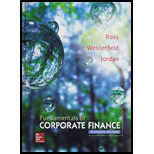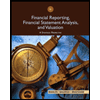
Fundamentals of Corporate Finance with Connect Access Card
11th Edition
ISBN: 9781259418952
Author: Stephen A. Ross Franco Modigliani Professor of Financial Economics Professor, Randolph W Westerfield Robert R. Dockson Deans Chair in Bus. Admin., Bradford D Jordan Professor
Publisher: McGraw-Hill Education
expand_more
expand_more
format_list_bulleted
Concept explainers
Textbook Question
Chapter 12.6, Problem 12.6ACQ
What is an
Expert Solution & Answer
Want to see the full answer?
Check out a sample textbook solution
Students have asked these similar questions
QUESTION 1
Examine the information provided below and answer the following question.
(10 MARKS)
The hockey stick model of start-up financing, illustrated by the diagram below, has received a lot of attention in the
entrepreneurial finance literature (Cumming & Johan, 2013; Kaplan & Strömberg, 2014; Gompers & Lerner, 2020). The model
is often used to describe the typical funding and growth trajectory of many startups. The model emphasizes three main
stages, each of which reflects a different phase of growth, risk, and funding expectations.
Entrepreneur, 3 F's
Debt(banks & microfinance)
Research Business angels/Angel Venture funds/Venture capitalists
Merger, Acquisition
Grants
investors
PO
Public market
Growth (revenue)
Break even
point
Pide
1st round
Expansion
2nd round
3rd round
Research
commercial idea
Pre-seed
Initial concept
Seed
Early
Expansion
Financial stage
Late
IPO
Inception and
prototype
Figure 1. The hockey stick model of start-up financing (Lasrado & Lugmayr, 2013)
REQUIRED:…
critically discuss the hockey stick model of a start-up financing. In your response, explain the model and discibe its three main stages, highlighting the key characteristics of each stage in terms of growth, risk, and funding expectations.
Solve this problem please .
Chapter 12 Solutions
Fundamentals of Corporate Finance with Connect Access Card
Ch. 12.1 - Prob. 12.1ACQCh. 12.1 - Why are unrealized capital gains or losses...Ch. 12.1 - What is the difference between a dollar return and...Ch. 12.2 - Prob. 12.2ACQCh. 12.2 - Why doesnt everyone just buy small stocks as...Ch. 12.2 - What was the smallest return observed over the 88...Ch. 12.2 - About how many times did large-company stocks...Ch. 12.2 - What was the longest winning streak (years without...Ch. 12.2 - How often did the T-bill portfolio have a negative...Ch. 12.3 - Prob. 12.3ACQ
Ch. 12.3 - What was the real (as opposed to nominal) risk...Ch. 12.3 - Prob. 12.3CCQCh. 12.3 - What is the first lesson from capital market...Ch. 12.4 - In words, how do we calculate a variance? A...Ch. 12.4 - With a normal distribution, what is the...Ch. 12.4 - Prob. 12.4CCQCh. 12.4 - What is the second lesson from capital market...Ch. 12.5 - Prob. 12.5ACQCh. 12.5 - Prob. 12.5BCQCh. 12.6 - What is an efficient market?Ch. 12.6 - Prob. 12.6BCQCh. 12 - Chase Bank pays an annual dividend of 1.05 per...Ch. 12 - The risk premium is computed as the excess return...Ch. 12 - Prob. 12.4CTFCh. 12 - Prob. 12.5CTFCh. 12 - Prob. 12.6CTFCh. 12 - Investment Selection [LO4] Given that Fannie Mae...Ch. 12 - Prob. 2CRCTCh. 12 - Risk and Return [LO2, 3] We have seen that over...Ch. 12 - Market Efficiency Implications [LO4] Explain why a...Ch. 12 - Efficient Markets Hypothesis [LO4] A stock market...Ch. 12 - Semistrong Efficiency [LO4] If a market is...Ch. 12 - Efficient Markets Hypothesis [LO4] What are the...Ch. 12 - Stocks versus Gambling [LO4] Critically evaluate...Ch. 12 - Efficient Markets Hypothesis [LO4] Several...Ch. 12 - Efficient Markets Hypothesis [LO4] For each of the...Ch. 12 - Calculating Returns [LO1] Suppose a stock had an...Ch. 12 - Calculating Yields [LO1] In Problem 1, what was...Ch. 12 - Prob. 3QPCh. 12 - Prob. 4QPCh. 12 - Nominal versus Real Returns [LO2] What was the...Ch. 12 - Bond Returns [LO2] What is the historical real...Ch. 12 - Prob. 7QPCh. 12 - Risk Premiums [LO2, 3] Refer to Table 12.1 in the...Ch. 12 - Calculating Returns and Variability [LO1] Youve...Ch. 12 - Calculating Real Returns and Risk Premiums [LO1]...Ch. 12 - Calculating Real Rates [LO1] Given the information...Ch. 12 - Prob. 12QPCh. 12 - Prob. 13QPCh. 12 - Calculating Returns and Variability [LO1] You find...Ch. 12 - Arithmetic and Geometric Returns [LO1] A stock has...Ch. 12 - Arithmetic and Geometric Returns [LO1] A stock has...Ch. 12 - Using Return Distributions [LO3] Suppose the...Ch. 12 - Prob. 18QPCh. 12 - Distributions [LO3] In Problem 18, what is the...Ch. 12 - Blumes Formula [LO1] Over a 40-year period an...Ch. 12 - Prob. 21QPCh. 12 - Calculating Returns [LO2, 3] Refer to Table 12.1...Ch. 12 - Using Probability Distributions [LO3] Suppose the...Ch. 12 - Using Probability Distributions [LO3] Suppose the...Ch. 12 - Prob. 1MCh. 12 - Prob. 2MCh. 12 - Prob. 3MCh. 12 - Prob. 4MCh. 12 - A measure of risk-adjusted performance that is...Ch. 12 - Prob. 6M
Knowledge Booster
Learn more about
Need a deep-dive on the concept behind this application? Look no further. Learn more about this topic, finance and related others by exploring similar questions and additional content below.Similar questions
- Take value of 1.01^-36=0.699 . step by steparrow_forwardsolve this question.Pat and Chris have identical interest-bearing bank accounts that pay them $15 interest per year. Pat leaves the $15 in the account each year, while Chris takes the $15 home to a jar and never spends any of it. After five years, who has more money?arrow_forwardWhat is corporate finance? explain all thingsarrow_forward
arrow_back_ios
SEE MORE QUESTIONS
arrow_forward_ios
Recommended textbooks for you
 Managerial Accounting: The Cornerstone of Busines...AccountingISBN:9781337115773Author:Maryanne M. Mowen, Don R. Hansen, Dan L. HeitgerPublisher:Cengage Learning
Managerial Accounting: The Cornerstone of Busines...AccountingISBN:9781337115773Author:Maryanne M. Mowen, Don R. Hansen, Dan L. HeitgerPublisher:Cengage Learning Cornerstones of Cost Management (Cornerstones Ser...AccountingISBN:9781305970663Author:Don R. Hansen, Maryanne M. MowenPublisher:Cengage Learning
Cornerstones of Cost Management (Cornerstones Ser...AccountingISBN:9781305970663Author:Don R. Hansen, Maryanne M. MowenPublisher:Cengage Learning Financial Reporting, Financial Statement Analysis...FinanceISBN:9781285190907Author:James M. Wahlen, Stephen P. Baginski, Mark BradshawPublisher:Cengage Learning
Financial Reporting, Financial Statement Analysis...FinanceISBN:9781285190907Author:James M. Wahlen, Stephen P. Baginski, Mark BradshawPublisher:Cengage Learning Intermediate Financial Management (MindTap Course...FinanceISBN:9781337395083Author:Eugene F. Brigham, Phillip R. DavesPublisher:Cengage Learning
Intermediate Financial Management (MindTap Course...FinanceISBN:9781337395083Author:Eugene F. Brigham, Phillip R. DavesPublisher:Cengage Learning

Managerial Accounting: The Cornerstone of Busines...
Accounting
ISBN:9781337115773
Author:Maryanne M. Mowen, Don R. Hansen, Dan L. Heitger
Publisher:Cengage Learning

Cornerstones of Cost Management (Cornerstones Ser...
Accounting
ISBN:9781305970663
Author:Don R. Hansen, Maryanne M. Mowen
Publisher:Cengage Learning

Financial Reporting, Financial Statement Analysis...
Finance
ISBN:9781285190907
Author:James M. Wahlen, Stephen P. Baginski, Mark Bradshaw
Publisher:Cengage Learning

Intermediate Financial Management (MindTap Course...
Finance
ISBN:9781337395083
Author:Eugene F. Brigham, Phillip R. Daves
Publisher:Cengage Learning
Efficient Market Hypothesis - EMH Explained Simply; Author: Learn to Invest - Investors Grow;https://www.youtube.com/watch?v=UTHvfI9awBk;License: Standard Youtube License